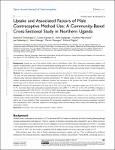| dc.identifier.citation | Tumwesigye, R., Kigongo, E., Nakiganga, S., Mbyariyehe, G., Nabeshya, J., Kabunga, A., Musinguzi, M., & Migisha, R.(2023) .Uptake and Associated Factors of Male Contraceptive Method Use: A Community-Based Cross-Sectional Study in Northern Uganda | en_US |
| dc.description.abstract | Background: Uganda has one of the highest fertility rates in Sub-Saharan Africa (SSA). Improving contraceptive uptake in all
genders, including males, may be critical to meeting family planning goals in such a setting. Yet, data on male contraception uptake
and associated factors in SSA, including Uganda, are limited. We determined the uptake and associated factors of male contraception
use in Lira City, Northern Uganda.
Methods: We conducted a community-based cross-sectional study from November 12, 2022, to December 12, 2022, among men aged
≥18 years. We used multi-stage sampling to select participants from 12 cells of Lira City divisions of East and West. Data were
collected using interviewer-administered structured questionnaires. We defined uptake in males who had used any contraceptive
method, including periodic abstinence, withdrawal, condoms, and vasectomy in the previous four weeks. We performed modified
Poisson regression to identify associated factors of male contraception uptake.
Results: We recruited 401 participants with mean age of 30.4 (±9.3) years. Male contraceptive uptake was 46.4%, 95% CI: 41.5–
51.3%. Ever heard about male contraception (adjusted prevalence ratio [aPR] =1.73, 95% CI: 1.172–2.539, p=0.006), willingness to
use novel methods (aPR=2.90, 95% CI: 1.337–6.293, p=0.007), both partners being responsible for contraception (aPR: 1.53, 95% CI:
1.113–2.119, p=0.009) were the factors associated with male contraception uptake.
Conclusion: We found that nearly half of the men surveyed had used male contraceptive methods in Lira City. Factors associated
with the uptake of male contraception included having heard about male contraception, joint couple decision regarding contraception,
and the use of novel methods of male contraception. We recommend comprehensive education and awareness campaigns to promote
male contraception, with a particular emphasis on encouraging shared decision-making within couples and introducing innovative
contraceptive options. | en_US |

